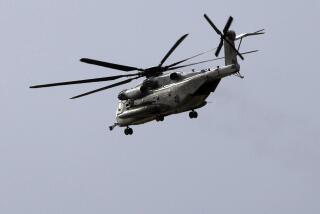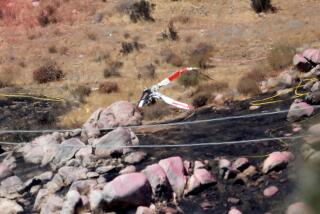U.S. Refits Copters to Fight Off Effect of Abrasive Sand : Desert operations: New gear also installed on craft to help guide pilots across faceless terrain.
DHAHRAN, Saudi Arabia â The U.S. military, acknowledging that helicopters have been damaged by blowing sand and pilots confused by the featureless terrain, has ordered the installation of special equipment on choppers deployed in the Saudi desert, officials said Saturday.
The hasty adaptations, which include new filters and protective coatings, are designed to help shield the sophisticated helicopters from the relentless abrasive effect of the fine desert sand that wears down vital engine parts and strips the surface from rotor blades.
Some of the choppers assigned to U.S. forces here also will be fitted with new satellite-linked equipment to help guide pilots across the faceless desert landscape that has made conventional navigation techniques difficult, the officials said.
The refitting program, using equipment shipped from the United States, follows a series of five crashes and emergency landings involving helicopters assigned to Operation Desert Shield. The causes of the crashes have not yet been identified.
The latest incident occurred Saturday night, when five U.S. soldiers were injured in the crash of a UH-60 Blackhawk helicopter during a night training mission in the Saudi desert, according to a U.S. military statement.
It said the helicopter belonged to the 17th Cavalry Regiment, 101st Airborne Division. No details on the crash or the condition of the soldiers were immediately available.
Officials said the difficulties encountered by chopper pilots here also serve as an unpleasant reminder of the ill-fated Desert One operation, the 1980 U.S. attempt to rescue hostages in Iran that failed after helicopters developed equipment and navigation problems.
The Armyâs all-purpose UH-1 Huey in particular is just âsucking up a lot of sand,â said one battalion commander. And Army Col. Robert N. Siegle, commander of all Army aviation units in Saudi Arabia, said the constant âsandblastingâ already had worn crucial parts âright down to the bare metal.â
âThere is no doubt that when you operate in the sand, you are somewhat degraded,â said Lt. Col. Michael Mulvenon, commander of a Chinook helicopter battalion based at Ft. Bragg, N.C.
Officials stressed that there was no indication that any of the crashes were related to equipment malfunctions. And Siegle, commander of the 18th Aviation Brigade, said he had expected the fine sand of Saudi Arabia to cause more helicopter maintenance problems than the Army has experienced so far.
The chopper problems experienced here follow a new study by the General Accounting Office concluding that the Armyâs high-tech Apache helicopter, expected to be a crucial weapon in the Persian Gulf if war comes, has failed to meet projected standards of performance.
The soon-to-be-released study, whose conclusions were first reported by CBS News, found the Apache to be unfit for combat more than half of the time, with engine components in need of replacement five times as frequently as expected.
But Army officials on Saturday said the report had been based on an overly narrow sample and that they remained confident in the capabilities of the Apache, the militaryâs premier aerial tank-killer. They said its combat-ready rate in Saudi Arabia has significantly exceeded Army standards.
In an environment hostile to helicopters, Siegle credited the readiness rates to the work of maintenance crews that he said had been âworking their fingers to the bone to make sure that these birds are ready to fly at a momentâs notice.â
Of the five helicopters that have crashed or made emergency landings since the mission began, two were Army OH-58 observation helicopters, one was a Navy SH-2H Sea King, one was a Marine Corps CH-53E Super Stallion, and one was the Blackhawk that crashed Saturday night. Only one serious injury has been reported.
Officials stressed that there was no proof that any of the crashes were related to equipment malfunctions, and issued a press release asserting that the accident rate during the Desert Shield mission to date has been lower than that of normal military operations.
In interviews, however, commanders acknowledged that the performance of several types of helicopters--particularly the Huey--had suffered considerably as a result of the sand.
The upgraded equipment, shipped to Saudi Arabia at what one maintenance officer described as âforce-feedâ pace, is generally being fitted to U.S. helicopters at forward bases where some pilots have spent weeks trying to become accustomed to the Saudi environment.
Among the devices being installed onto Huey and other helicopters, officials said, are improved particle separation (IPS) filters designed to strip sand from the air as it is sucked into the engine, thus minimizing damage to fragile turbine blades. Installation of the equipment, which began before the deployment, has been stepped up sharply as a result of the Middle East operations.
At the same time, in a step conceived especially for the Desert Shield mission, maintenance workers have been instructed to cover Huey, Blackhawk and Apache helicopter rotor blades with protective coatings of epoxy or tape to help minimize sand-related damage. Without the modifications, the blades could require replacement after as few as 150 hours of flying.
To improve navigation, some Marine Cobra helicopters have been fitted with satellite-assisted systems capable of identifying a location anywhere in the world within a square meter.
âIâd get lost without it,â one Marine pilot said in an interview last week.
Army officials said they hoped to install similar devices in their Huey and Chinook helicopters due to their own pilotsâ concerns about navigation in the desert. But to a large extent, they said, the solution is more training flights.
âYou need time in areas like this to get aviators accustomed to the terrain,â said Siegle. To date, he said, referring to problems of depth perception over the bleak landscape, âWeâve had some difficulty finding the ground.â
More to Read
Sign up for Essential California
The most important California stories and recommendations in your inbox every morning.
You may occasionally receive promotional content from the Los Angeles Times.










